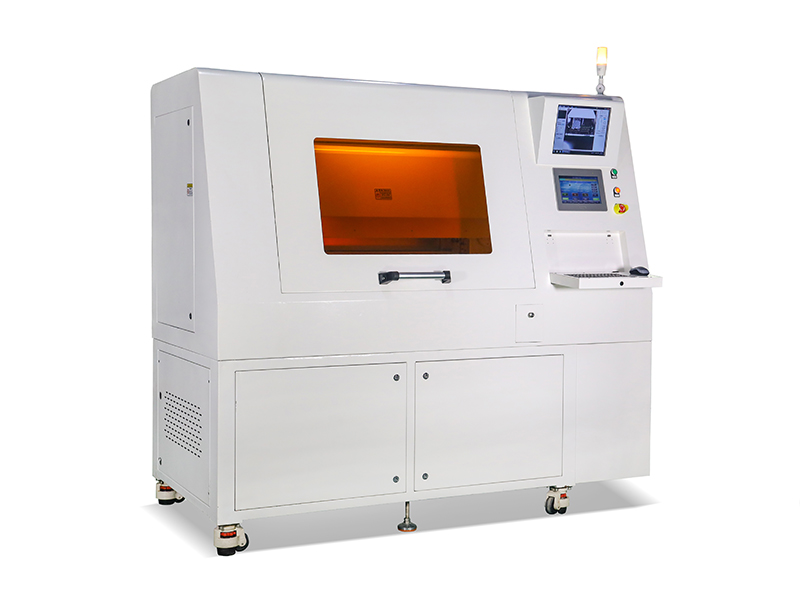Product Name: MQ-201 Automatic Slice Grinding Machine

Equipment Outline Dimensions:

Equipment Specifications:
power supply | AC 220V 3KW ( 50 HZ ) single phase |
Inlet and outlet | General city water pipe diameter 4 minutes |
air pressure | 6~8KG |
polishing liquid | Alumina powder preparation 3 ~ 5μm |
Dimensions | Length 2100 MM * Width 1000 MM * Height 2190 MM |
total weight of the machine | About 1000kg |
Slice position calibration | Use the vision system to automatically adjust the angle and alignment |
Grinding Disc Configuration | 4 (coarse, fine, fine, polished) |
Grinding disc size | Diameter 150MM |
The maximum size of slices can be clipped | Length 20MM * Width 20MM * Thickness 20MM |
Feeding method | Automatic continuous feeding |
grinding time | 2 to 3 minutes |
Grinding accuracy | ±10μm |
Equipment function and operation process introduction:
1. Workflow
A automatic feeding - B automatic visual calibration - C slice rough grinding - D slice fine grinding - E slice fine grinding - F slice polishing - G water washing - H discharge
2. After starting the machine, the slices enter the machine through the conveyor belt ;
3. After reaching the position, the robotic arm automatically grabs and loads the material ;
4. Use the vision system for automatic identification of position and angle calibration;
5. Rough cutting, fine grinding, fine grinding, polishing and washing will be performed automatically in sequence after automatic calibration;
6. While the machine is grinding, the operator can put the next batch of slices to be ground on the feeding conveyor belt;
7. After grinding and polishing is completed, the machine will automatically discharge to the discharge conveyor belt point, and the slices will be automatically discharged along with the discharge conveyor belt;
8. According to the needs of slice analysis, the operation process can be customized;
9. Grinding method: horizontal grinding;
10. It can grind soft board, hard board, parts board and various material boards.
Manual vs. Automatic Equipment Grinding Comparison Table:
Manual grinding | automatic grinding | |
Slice sampling | Slice length: 5~15 mm Slice width: 5~15 mm Slice thickness: 0.1 ~ 6 mm | Slice length: 16 mm Slice width: 14 mm Slice thickness: 0.1 ~ 12 mm |
mosaic | 1. Disposable mold: length 25 * height 20 * thickness (10 ~ 20) mm; 2. Persistent mold: length 25 * height 20 * thickness (20 ~ 30) mm. | 1. Acrylic sheet mold: length 20 * height 20 * thickness 20 mm; 2. Automation requirements: a. Need to control the verticality of the slice mosaic; b. Need to control the transparency of the slice mosaic. |
grind | 1. It is necessary to check the grinding depth while grinding, whether it has reached the designated grinding position; 2. The control of the horizontal angle during the grinding process is not easy; 3. The row holes are not easy to grind out at the same time. | 1. Professional software and mechanism design to calibrate the grinding position and coordinates; 2. Automatically adjust and control the horizontal grinding angle; 3. The holes can be milled at the same time; 4. The grinding depth is controlled within ±10μm, which is beneficial to grinding analysis. |
Manual vs. Automation Benefit Comparison Table:
Manual grinding | automatic grinding | |
Consumables | 1. Due to the large grinding area required for manual grinding, the use of disposable glue-filling molds or permanent glue-filling molds and fixed glues have higher costs; 2. The effective use area of sandpaper is about 60-70%; 3. When fine grinding, the slices must have a large grinding allowance to lose the sandpaper. | 1. Use acrylic sheet mold for inlay, with small grinding area and use of fixing glue, can be inlaid on both sides at the same time and the speed is fast; 2. The effective use area of sandpaper is about 80-90%; 3. During fine grinding, only 20-50μm of grinding allowance is left for the slices to save sandpaper loss. |
output | It takes about 5 to 10 minutes to grind one slice on average, and 144 to 72 slices can be completed in 12 hours per shift. | It takes about 2 to 3 minutes to grind one slice on average, and 720 to 360 slices can be completed in 12 hours per shift. |
quality | 1. The grinding angle is not easy to control; 2. It is not easy to grind out the holes at the same time; 3. The failure rate of small hole grinding is high and time-consuming; 4. It is not easy to control the grinding depth, so it is not conducive to fault grinding analysis. | 1. The grinding angle can be automatically identified and adjusted; 2. The row holes can be ground at the same time after being calibrated; 3. The grinding time of large and small holes is the same, and the success rate is more than 99.9%; 4. The grinding depth can be precisely controlled, which is conducive to fault grinding analysis. |
Product effect display:



Mobile: 180-8888-6977 (Mr. Li) Tel: 0755-23341037 QQ: 345976346
Add: Plant No. 224, Guangtian Road, Tangxiayong Community, Yanluo Street, Baoan District, Shenzhen

SCAN

SWEEP
